New bike transporter on Squirrel
Traveling in Squirrel, even very long distances, is a joy, but carrying two long tail cargo bikes and full camping gear inside the van can be a bit of a chore, every day loading the van is a 3 dimensional game of Tetris to get it all back in. It fits – but only in a limited number of ways.
We have considered many ways of carrying a bike or two on the back of the van, but there are issues with most of them. Our bikes are long, over two metres long for the Yuba, so they won’t really fit across the van without overhanging a long way. Racks to carry bikes vertically are expensive and usually designed to carry mountain bikes. We also considered a light weight trailer, but even though the trailer and van together would be shorted than some cars, the ferry companies to cross between the North and South Islands of New Zealand would just about double our fare if we added a trailer.
On top of that all the above solutions require a tow bar, which is not recommended on the van, nor readily available here.
One possibility I looked at was a bike rack that fits onto the tailgate. These tend to be flimsy affairs and hold the bike horizontally across the back of the van, so unsuitable in two ways, but I like the idea.
I have spent four years designing brackets that bolted under the van, clever hinge systems to allow the bikes to be loaded and swung into place, but all are way beyond my engineering capabilities. Eventually a few concepts started to gel together. Firstly, carrying the bikes without the front wheels greatly reduces the length (of my Yuba at least). Secondly, the structure of the bikes and the van is strong enough to make any rack requirement a positional thing, not necessarily a weight bearing thing. Thirdly, the bikes have to be mounted vertically, with as little as possible extending over the top of the van. While thinking and talking this through with Lynn, it became clear that she was not happy with her beautiful Tern GSD Gen 1 being carried outside the van. Not a deal breaker, one bike in the van is much easier to manage than two.
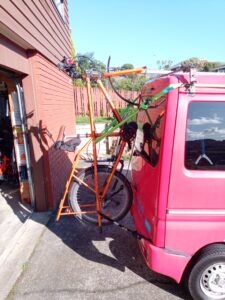
Rather than describe what I have done, here are some photos with commentary that explain the main features.
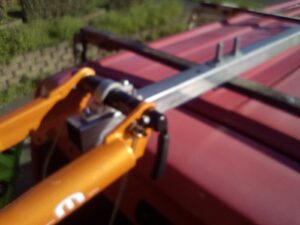
So the basic idea is that the front wheel is replaced by a dummy axle from which the bike can hang. The van has a short length of guttering at the back of the van, and I have a pair of roof bars which are plain steel bars that attach to the gutters, about 500mm apart. I have created a 30mm square bar that attaches to both cross bars, and extends out the back 250mm. At the rear of this I have a bracket, which I found in my bits boxes. The dummy axle drops into the bracket, and a bracket over the top holds the axle into the lower bracket. The bike is only supported by this bracket while the bike is being loaded, the weight is taken by other devices when fully attached. It does however hold the dummy axle in position when tension is applied to the mounting system.
Having hung the bike off the roof racks, the bike is firmly strapped to the van with two ratchet straps at the top, and two at the bottom. The two top straps attach to the seat stays and go forwards and up to attach to the roof bar legs, where they attach to the van. When these are tensioned (equally) the upward tension lifts the bike, putting upward pressure on the hanging bracket, and the forward tension draws the bike in towards the van, and the sideways tension hold the bike horizontally so it doesn’t swing going around corners. Each end of the upper straps attaches to a different roof bar to spread the load.
The bottom straps are attached just above the rear drop outs (where the rear wheel attaches to the bike) and the straps go forward and slightly down to attach with steel clips to the wheel arches, going under the corner of the rear door. These straps add further sideways tension to stop the bike swinging, more forward tension to hold the bike to the van (specifically holding the rear tyre against the back bumper of the van, and slightly downward tension to oppose the upward tension from the top strap.
Not a lot of tension is required in any strap, but it is important that all straps are tight and located correctly.
All the vehicles lights are still visible from the rear, and I will have a supplementary number plate which will be attached to the bike which hides the normal plate.
The bike sits slightly to one side, as the roof has ridges down the length of it, and the centre ridge gets very close to the centre support brackets on the roof rack if it is pt in the middle. Putting it to one side puts the bracket in between two ridges, giving more clearance.
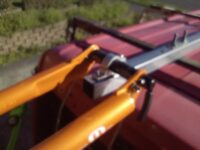
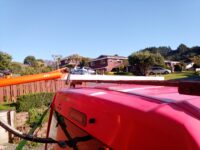
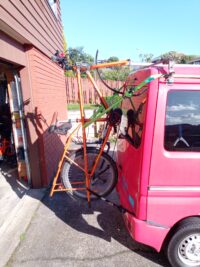
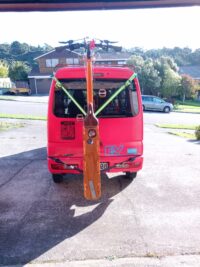
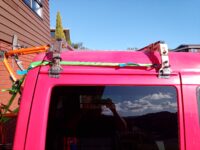
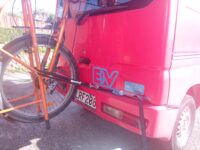
Leave a Reply